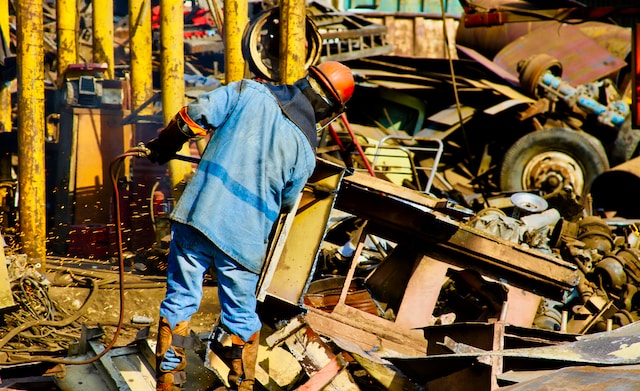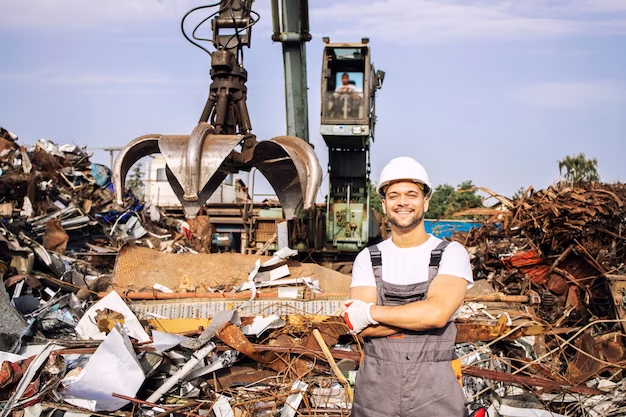What Are Some Common Health & Safety Concerns With Vehicle Recycling
Vehicle recycling, while important for sustainability, presents significant health and safety concerns that must be addressed to protect workers and communities. We look at the primary health and safety issues associated with vehicle recycling, highlighting common hazards, necessary safety measures, relevant regulations, technological advancements, and real-world examples.
Common Health Hazards in Vehicle Recycling
Health and safety concerns in vehicle recycling primarily arise from exposure to hazardous materials and the risk of injury from machinery. The dismantling of vehicles exposes workers to various dangerous substances and physical risks.

Image source: https://corptemps.com/wp-content/uploads/2023/09/scrap-yard-worker.jpg
Exposure to Hazardous Materials
One of the most significant health hazards in vehicle recycling is exposure to hazardous materials. These materials include lead, mercury, cadmium, and various other toxic substances found in different parts of vehicles. Workers can inhale or come into contact with these substances, leading to severe health issues such as respiratory problems, neurological damage, and even cancer.
- Lead: Commonly found in batteries and some electrical components, lead exposure can cause serious health problems, including kidney damage and nervous system disorders.
- Mercury: Used in switches and lighting, mercury is highly toxic, affecting the brain and kidneys, and can cause developmental issues in children.
- Cadmium: Found in batteries, cadmium exposure can lead to lung and prostate cancer, as well as kidney disease.
Risk of Injury from Machinery
The recycling process involves heavy machinery, which poses significant physical risks to workers. Injuries can occur during the dismantling of vehicles, the crushing of metal, and the operation of various recycling machines.
- Crushing and Cutting Machines: Workers can suffer from cuts, amputations, and crushing injuries due to improper handling or malfunction of these machines.
- Heavy Lifting: Manual handling of heavy vehicle parts can result in musculoskeletal injuries, including back pain and hernias.
- Fire and Explosions: The presence of flammable liquids and gases in vehicles can lead to fires and explosions if not handled properly.
Respiratory Issues from Dust and Fumes
Dust and fumes generated during the recycling process can lead to serious respiratory issues for workers. Grinding, cutting, and shredding of vehicle parts release airborne particles that can be inhaled, causing lung damage and other respiratory problems.
- Asbestos: Often present in older vehicles’ brake pads and insulation, asbestos fibers can cause lung cancer and mesothelioma when inhaled.
- Silica Dust: Generated from cutting and grinding, inhaling silica dust can lead to silicosis, a severe lung disease.
Safety Measures and Regulations
To mitigate these health and safety risks, various safety measures and regulations must be implemented and adhered to. Ensuring the safety of workers in vehicle recycling facilities requires a combination of protective equipment, workplace protocols, and compliance with regulatory standards.
Personal Protective Equipment (PPE)
Personal Protective Equipment (PPE) is essential in minimizing exposure to hazardous materials and physical injuries.
- Respirators and Masks: Protect against inhalation of toxic fumes and dust particles.
- Gloves and Protective Clothing: Shield skin from contact with hazardous substances and prevent cuts and abrasions.
- Safety Goggles: Protect eyes from flying debris and chemical splashes.
- Ear Protection: Mitigate the risk of hearing damage from noisy machinery.
Workplace Safety Standards
Implementing and enforcing strict workplace safety standards is crucial to prevent accidents and injuries.
- Training Programs: Regular training sessions ensure workers are aware of potential hazards and know how to handle equipment safely.
- Safety Protocols: Establishing clear protocols for the operation of machinery and handling of hazardous materials reduces the risk of accidents.
- Emergency Procedures: Having well-defined emergency procedures, including evacuation plans and first aid, helps manage incidents effectively.
Regulatory Bodies and Compliance
Adherence to regulations set by bodies such as Safe Work Australia is mandatory to ensure worker safety.
- Safe Work Guidelines: Compliance with Safe Work guidelines, which cover various aspects of workplace safety, is essential. These guidelines include standards for exposure limits, use of PPE, and safety training.
- Local and International Regulations: Abiding by both local and international safety regulations ensures a comprehensive approach to worker safety.
Technological Advances in Safety
Technological innovations play a significant role in enhancing safety in vehicle recycling. Advances in automation, protective gear, and monitoring systems help reduce health risks and improve overall safety.
Automation
Automating hazardous tasks reduces direct exposure of workers to dangerous conditions.
- Robotics: Robots can perform high-risk tasks such as dismantling and sorting, minimizing human involvement in potentially dangerous processes.
- Automated Handling Systems: These systems can transport heavy vehicle parts, reducing the risk of musculoskeletal injuries.
Advanced Protective Gear
Innovations in protective gear have significantly improved worker safety.
- Enhanced Respirators: Modern respirators provide better protection against toxic fumes and particles.
- Cut-Resistant Gloves: Advanced materials used in gloves offer greater protection against cuts and abrasions.
Monitoring Systems
Real-time monitoring systems help detect and mitigate hazards promptly.
- Air Quality Monitors: These devices detect harmful airborne particles and gases, allowing for immediate action to protect workers.
- Safety Sensors: Sensors on machinery can detect malfunctions or unsafe operating conditions, triggering automatic shutdowns to prevent accidents.
Case Studies and Real-World Examples
Examining case studies and real-world examples of health and safety practices in vehicle recycling provides valuable insights and lessons.
Success Stories of Safe Recycling Practices
There are several success stories where companies have effectively implemented safety measures, leading to safer work environments.
- Example 1: A vehicle recycling facility in Germany adopted comprehensive safety protocols, including the use of advanced PPE and regular training sessions. As a result, they reported a significant reduction in workplace injuries and health issues.
- Example 2: A U.S.-based recycling company introduced automated systems and advanced monitoring technologies, which drastically reduced exposure to hazardous materials and improved overall safety.
Lessons from Accidents
Learning from past accidents helps in understanding what went wrong and how to prevent similar incidents in the future.
- Case 1: An incident at a recycling plant involved a fire caused by improper handling of flammable materials. The investigation revealed a lack of proper training and inadequate emergency procedures, leading to the implementation of stricter safety protocols.
- Case 2: A worker suffered severe injuries due to malfunctioning machinery. The accident underscored the importance of regular maintenance and safety checks on equipment, prompting the company to enhance their machinery inspection protocols.
Final Points
Health and safety concerns in vehicle recycling are significant but manageable with the right measures in place. The primary hazards include exposure to toxic substances, risks from heavy machinery, and respiratory issues from dust and fumes. Addressing these concerns requires the use of personal protective equipment, adherence to safety standards and regulations, and leveraging technological advancements.
Real-world examples demonstrate the effectiveness of these measures, highlighting the importance of ongoing vigilance and continuous improvement in safety practices. By prioritizing health and safety, the vehicle recycling industry can protect its workers and contribute positively to environmental sustainability.

